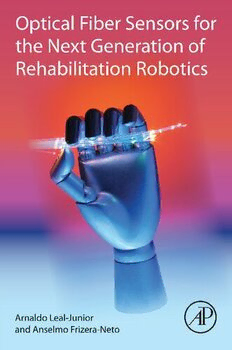
Optical Fiber Sensors for the Next Generation of Rehabilitation Robotics PDF
Preview Optical Fiber Sensors for the Next Generation of Rehabilitation Robotics
Optical Fiber Sensors for the Next Generation of Rehabilitation Robotics This page intentionally left blank Optical Fiber Sensors for the Next Generation of Rehabilitation Robotics Arnaldo Leal-Junior MechanicalEngineeringDepartment FederalUniversityofEspiritoSanto Vitória,Brazil Anselmo Frizera-Neto ElectricalEngineeringDepartment FederalUniversityofEspiritoSanto Vitória,Brazil AcademicPressisanimprintofElsevier 125LondonWall,LondonEC2Y5AS,UnitedKingdom 525BStreet,Suite1650,SanDiego,CA92101,UnitedStates 50HampshireStreet,5thFloor,Cambridge,MA02139,UnitedStates TheBoulevard,LangfordLane,Kidlington,OxfordOX51GB,UnitedKingdom Copyright©2022ElsevierInc.Allrightsreserved. Nopartofthispublicationmaybereproducedortransmittedinanyformorbyanymeans, electronicormechanical,includingphotocopying,recording,oranyinformationstorageand retrievalsystem,withoutpermissioninwritingfromthepublisher.Detailsonhowtoseek permission,furtherinformationaboutthePublisher’spermissionspoliciesandourarrangements withorganizationssuchastheCopyrightClearanceCenterandtheCopyrightLicensingAgency, canbefoundatourwebsite:www.elsevier.com/permissions. Thisbookandtheindividualcontributionscontainedinitareprotectedundercopyrightbythe Publisher(otherthanasmaybenotedherein). Notices Knowledgeandbestpracticeinthisfieldareconstantlychanging.Asnewresearchand experiencebroadenourunderstanding,changesinresearchmethods,professionalpractices,or medicaltreatmentmaybecomenecessary. Practitionersandresearchersmustalwaysrelyontheirownexperienceandknowledgein evaluatingandusinganyinformation,methods,compounds,orexperimentsdescribedherein.In usingsuchinformationormethodstheyshouldbemindfuloftheirownsafetyandthesafetyof others,includingpartiesforwhomtheyhaveaprofessionalresponsibility. Tothefullestextentofthelaw,neitherthePublishernortheauthors,contributors,oreditors, assumeanyliabilityforanyinjuryand/ordamagetopersonsorpropertyasamatterofproducts liability,negligenceorotherwise,orfromanyuseoroperationofanymethods,products, instructions,orideascontainedinthematerialherein. LibraryofCongressCataloging-in-PublicationData AcatalogrecordforthisbookisavailablefromtheLibraryofCongress BritishLibraryCataloguing-in-PublicationData AcataloguerecordforthisbookisavailablefromtheBritishLibrary ISBN:978-0-323-85952-3 ForinformationonallAcademicPresspublications visitourwebsiteathttps://www.elsevier.com/books-and-journals Publisher:MaraConner AcquisitionsEditor:SonniniR.Yura EditorialProjectManager:IsabellaC.Silva ProductionProjectManager:SojanP.Pazhayattil Designer:VictoriaPearson TypesetbyVTeX Contents Preface ix Part I Introduction to soft robotics and rehabilitation systems 1. Introductionandoverviewofwearabletechnologies 1.1 Motivation 3 1.2 Wearableroboticsandassistivedevices 10 1.3 Wearablesensorsandmonitoringdevices 14 1.4 Outlineofthebook 18 References 21 2. Softwearablerobots 2.1 Softrobots:definitionsand(bio)medicalapplications 27 2.2 Softrobotsforrehabilitationandfunctionalcompensation 30 2.3 Human-in-the-loopdesignofsoftstructuresandhealthcare systems 34 2.3.1 Human-in-the-loopsystems 34 2.3.2 Human-in-the-loopapplicationsandcurrenttrends 37 2.3.3 Human-in-the-loopdesigninsoftwearablerobots 39 2.4 Currenttrendsandfutureapproachesinwearablesoftrobots 43 References 46 3. Gaitanalysis:overview,trends,andchallenges 3.1 Humangait 53 3.2 Gaitcycle:definitionsandphases 56 3.2.1 Kinematicsanddynamicsofhumangait 57 3.3 Gaitanalysissystems:fixedsystemsandwearablesensors 58 References 61 v vi Contents Part II Introduction to optical fiber sensing 4. Opticalfiberfundamentsandoverview 4.1 Historicalperspective 67 4.2 Lightpropagationinopticalwaveguides 69 4.3 Opticalfiberpropertiesandtypes 72 4.4 Passiveandactivecomponentsinopticalfibersystems 76 4.4.1 Lightsources 77 4.4.2 Photodetectors 77 4.4.3 Opticalcouplers 79 4.4.4 Opticalcirculators 80 4.4.5 Spectrometersandopticalspectrumanalyzers 81 4.5 Opticalfiberfabricationandconnectionmethods 83 4.5.1 Fabricationmethods 84 4.5.2 Opticalfiberconnectorizationapproaches 87 References 89 5. Opticalfibermaterials 5.1 Opticallytransparentmaterials 93 5.2 Viscoelasticityoverview 96 5.3 Dynamicmechanicalanalysisinpolymeropticalfibers 101 5.3.1 DMAonPMMAsolidcorePOF 103 5.3.2 DynamiccharacterizationofCYTOPfibers 107 5.4 Influenceofopticalfibertreatmentsonpolymerproperties 111 References 115 6. Opticalfibersensingtechnologies 6.1 Intensityvariationsensors 119 6.1.1 Macrobendingsensors 120 6.1.2 Lightcoupling-basedsensors 125 6.1.3 Multiplexedintensityvariationsensors 127 6.2 Interferometers 129 6.3 Gratings-basedsensors 133 6.4 Compensationtechniquesandcross-sensitivitymitigationin opticalfibersensors 138 References 143 Part III Optical fiber sensors in rehabilitation systems 7. Wearablerobotsinstrumentation 7.1 Opticalfibersensorsonexoskeleton’sinstrumentation 151 Contents vii 7.2 Exoskeleton’sangleassessmentapplicationswithintensity variationsensors 152 7.2.1 Casestudy:activelowerlimborthosisforrehabilitation (ALLOR) 156 7.2.2 Casestudy:modularexoskeleton 157 7.3 Human-robotinteractionforcesassessmentwithFiberBragg Gratings 160 7.4 Interactionforcesandmicroclimateassessmentwithintensity variationsensors 166 References 172 8. Smartstructuresandtextilesforgaitanalysis 8.1 Opticalfibersensorsforkinematicparametersassessment 175 8.1.1 Intensityvariation-basedsensorsforjointangle assessment 175 8.1.2 FiberBragggratingssensorswithtunablefilter interrogationforjointangleassessment 178 8.2 Instrumentedinsoleforplantarpressuredistributionand groundreactionforcesevaluation 183 8.2.1 FiberBragggratinginsoles 183 8.2.2 Multiplexedintensityvariation-basedsensorsforsmart insoles 188 8.3 Spatiotemporalparametersestimationusingintegratedoptical fibersensors 198 References 199 9. Softroboticsandcompliantactuatorsinstrumentation 9.1 Serieselasticactuatorsinstrumentation 201 9.1.1 Torquemeasurementwithintensityvariationsensors 202 9.1.2 Torquemeasurementwithintensityvariationsensors 206 9.2 Tendon-drivenactuatorsinstrumentation 212 9.2.1 Artificialtendoninstrumentationwithhighlyflexible opticalfibers 213 References 217 Part IV Case studies and additional applications 10. Wearablemultifunctionalsmarttextiles 10.1 Opticalfiberembedded-textilesforphysiologicalparameters monitoring 223 10.1.1 Breathandheartratesmonitoring 224 10.1.2 Bodytemperatureassessment 232 10.2 Smarttextileformultiparametersensingandactivities monitoring 234 viii Contents 10.3 Opticalfiber-embeddedsmartclothingformechanical perturbationandphysicalinteractiondetection 239 References 241 11. Smartwalker’sinstrumentationanddevelopmentwith compliantopticalfibersensors 11.1 Smartwalkers’technologyoverview 245 11.2 Smartwalkerembeddedsensorsforphysiologicalparameters assessment 247 11.2.1 Systemdescription 247 11.2.2 Preliminaryvalidation 250 11.2.3 Experimentalvalidation 252 11.3 Multiparameterquasidistributedsensinginasmartwalker structure 252 11.3.1 Experimentalvalidation 252 11.3.2 Experimentalvalidation 256 References 260 12. Opticalfibersensorsapplicationsforhumanhealth 12.1 Roboticsurgery 263 12.2 Biosensors 269 12.2.1 Introductiontobiosensing 269 12.2.2 Backgroundonopticalfiberbiosensingworking principles 271 12.2.3 Biofunctionalizationstrategiesforfiberimmunosensors 276 12.2.4 Immunosensingapplicationsinmedicalbiomarkers detection 279 References 282 13. Conclusionsandoutlook 13.1 Summary 287 13.2 Finalremarksandoutlook 290 Index 293 Preface Theadvancesinmedicineandphysicaltherapyinconjunctionwithnewdevel- opments of mechatronic devices with a higher level of controllability enabled the development of assistive robotic devices, which are explored by many re- search groups around the world. Concurrently, there is the development and widespread of optical fiber technology, which is increasingly used as sensors devices. The optical fiber sensors characteristics are well aligned with the re- quirementsofroboticinstrumentation,especiallytheoneswithelectricmotors, commonly used in wearable robots: Optical fiber sensors are immune to elec- tromagneticperturbationsofferingprecisemeasurementsinnoiseenvironments. In addition, the flexibility of optical fibers is also aligned with the new trends insoftandflexibleroboticsystems,wherethesensorscanbeembeddedinthe robot’sstructureortheycanbeplacedonwearabledevicesforpatientmonitor- ing.Yearsago,alloftheseadvancesresultedinanewresearchdirection,where theopticalfibersensorswereusedontherobots’instrumentationtoextendtheir controlcapabilitiesbymeasuringparametersthatwerenotcommonlymeasured withconventionalelectromechanicalsensors. The results of years of research in robotics and optical fiber sensors in a jointeffortoftheGraduatePrograminElectricalEngineeringandMechanical EngineeringDepartmentoftheFederalUniversityofEspiritoSanto(UFES)are summarized in this book. The aim of this book is to provide a comprehensive understanding on this new research topic and its underlying theory and prin- ciples. This book was proposed and conceived under the assumption that the next generation of wearable robots and devices not only will include the soft structureandcompliantactuators,butalsothenewopticalfibersensorsembed- dedinthe robots’structure andactuationunits.We dividedthebookintofour parts. In the first part of this book, the developments in wearable robots and assistive devices as well as human-in-the-loop design and the recent develop- mentsonsoftroboticsarediscussed.Inthesecondpart,thefocusisshiftedto opticalfibersincludingthepresentationofanoverview,themaincomponents, andcharacteristicsofanopticalfiber-baseddetectionsystemandthematerials commonlyusedonthedevelopmentofopticalsensors.Moreover,opticalfiber sensorsapproachesarepresented.Thethirdpartpresentstheopticalfiber-based instrumentation systems in wearable robots and assistive devices, resulting in ix
